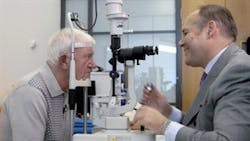First dry age-related macular-degeneration (AMD) patient receives the Argus II retinal implant
| Ray Flynn (left) has received a retinal implant that gives him perception in his central vision for the first time in many years. At right is Paulo Stanga, the ophthalmologist and surgeon. (Image: Manchester Royal Eye Hospital) |
Manchester Royal Eye Hospital (Manchester, England) and Second Sight Medical Products (Sylmar, CA; NASDAQ: EYES) say they are pleased by early stage tests on the world's first ever dry age related macular degeneration (AMD) patient to receive the Argus II retinal implant, popularly called a "bionic eye."
Paulo Stanga, Consultant ophthalmologist and vitreoretinal surgeon at the Manchester Royal Eye Hospital and Professor of Ophthalmology and Retinal Regeneration at The University of Manchester, says that initial screening tests on 80-year-old Ray Flynn, from Manchester, have shown that he has perception in his central vision for the first time in many years. With the Argus II system switched on, Flynn is able to make out the outline of people and objects even with his eyes closed, which shows that he is not using any of his remaining natural vision to identify the shapes and outlines.
The procedure to implant Flynn took place on June 16, 2015 in a four-hour procedure. Flynn's system was turned on for the first time on July 1, 2015. Tests carried out the same day consisted of the patient looking at a computer screen and identifying black and white patterns at different orientations. The patient's ability to correctly identify the direction of the lines and the difference between the diagonal and horizontal lines shows that the Argus II device is providing central visual function that did not exist prior to the patient being implanted. It is expected that with practice and rehabilitation, Flynn's vision will continue to improve.
The implant is part of a feasibility study that aims to evaluate the safety and utility of the Argus II System in individuals with late-stage dry AMD, a condition that severely affects their central vision.
Miniature glasses-mounted camera
The Argus II works by converting video images captured by a miniature camera housed in the patient's glasses into a series of electrical pulses that are transmitted wirelessly to electrodes on the surface of the retina. These pulses stimulate the retina's remaining cells resulting in the corresponding perception of patterns of light in the brain. The patient then learns to interpret these visual patterns to regain some visual function.
Eligibility for the study includes patients 25 to 85 years of age with advanced dry AMD, some residual light perception, and a previous history of useful form vision. Study subjects will be followed for three years to evaluate safety and utility of the Argus II system on visual function. Pending positive study results, the Company plans to conduct a larger study to support market approvals. It is estimated that two million individuals worldwide are legally blind due to AMD and 375,000 people are blinded by retinitis pigmentosa (RP). The Argus II has already been tested and approved in the United States and Europe for individuals with RP and outer retinal degeneration, respectively.
Gregoire Cosendai, VP of Europe for Second Sight Medical Products, says, "The difference between patients with dry AMD and patients with RP is that the AMD patients retain some peripheral vision. RP patients with severe disease have no peripheral vision. This is why we have focused on treating RP patients first. This study will aim to establish whether the retention of some peripheral vision in dry AMD patients with severe sight loss -- functionally blind patients -- can benefit from artificial vision in their central visual field as well as using their remaining peripheral natural vision. This is totally groundbreaking research."
The Argus II has now been implanted in more than 130 patients; several patients have been using the system for more than seven years.
Sources:
http://investors.secondsight.com/releasedetail.cfm?ReleaseID=923158
